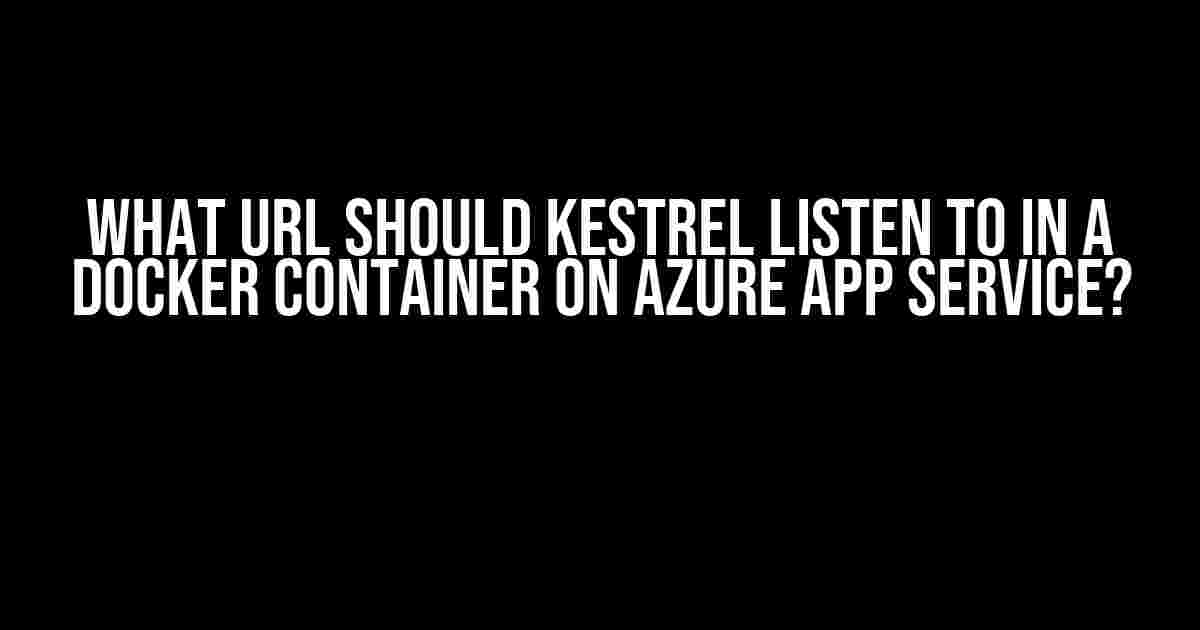Are you tired of scratching your head trying to figure out what URL Kestrel should listen to in a Docker container on Azure App Service? Well, you’re in luck because today, we’re going to dive into the world of containerized .NET applications and explore the best practices for configuring Kestrel to listen to the right URL.
What is Kestrel?
Kestrel is a lightweight, open-source web server for .NET Core and ASP.NET Core applications. It’s the default web server for ASP.NET Core projects and provides a flexible and scalable way to host web applications.
Why Do We Need to Configure Kestrel?
When running a .NET Core application in a Docker container on Azure App Service, Kestrel needs to be configured to listen to the correct URL. This is because Azure App Service provides a reverse proxy that forwards requests from the internet to your containerized application. If Kestrel is not configured correctly, your application won’t receive any requests.
Understanding the Azure App Service Environment
Azure App Service provides a unique environment for hosting web applications. Each App Service plan has a unique IP address and a domain name (e.g., myapp.azurewebsites.net). When you deploy a containerized application to Azure App Service, it’s exposed to the internet through this domain name.
To route requests to your containerized application, Azure App Service uses a reverse proxy. This proxy forwards incoming requests from the internet to your container, using an internal IP address and port (e.g., localhost:8080). Your application needs to listen to this internal IP address and port to receive incoming requests.
What URL Should Kestrel Listen to?
Now that we understand the Azure App Service environment, let’s answer the million-dollar question: what URL should Kestrel listen to?
The answer is simple: Kestrel should listen to http://+:8080. Yes, you read that correctly – http://+:8080!
The + symbol is a special character in Windows that represents all available network interfaces, including the internal IP address provided by Azure App Service. By using http://+:8080, Kestrel will listen to all available network interfaces on port 8080, which is the default port used by Azure App Service for containerized applications.
Configuring Kestrel in Docker
To configure Kestrel to listen to the correct URL, you’ll need to update your Dockerfile and the application’s configuration.
FROM mcr.microsoft.com/dotnet/core/sdk:3.1 # Set the ASPNETCORE_URLS environment variable ENV ASPNETCORE_URLS=http://+:8080 # Copy the application files COPY . /app # Set the working directory WORKDIR /app # Run the application ENTRYPOINT ["dotnet", "MyApplication.dll"]
In the example above, we set the ASPNETCORE_URLS environment variable to http://+:8080. This tells Kestrel to listen to all available network interfaces on port 8080.
Configuring Kestrel in the Application
In addition to configuring the Dockerfile, you’ll also need to update your application’s configuration to use the correct URL.
using Microsoft.AspNetCore;
using Microsoft.AspNetCore.Hosting;
using Microsoft.Extensions.Hosting;
namespace MyApplication
{
public class Program
{
public static void Main(string[] args)
{
CreateHostBuilder(args).Build().Run();
}
public static IHostBuilder CreateHostBuilder(string[] args) =>
Host.CreateDefaultBuilder(args)
.ConfigureWebHostDefaults(webBuilder =>
{
webBuilder.UseStartup<Startup>();
webBuilder.UseUrls("http://+:8080");
});
}
}
In the example above, we use the UseUrls method to specify the URL that Kestrel should listen to. In this case, we’re using http://+:8080, which is the same URL we set in the Dockerfile.
Conclusion
Configuring Kestrel to listen to the correct URL in a Docker container on Azure App Service is a crucial step in deploying a .NET Core application. By setting the ASPNETCORE_URLS environment variable to http://+:8080 and updating the application’s configuration to use the correct URL, you can ensure that your application receives incoming requests.
Remember, the key to success lies in understanding the Azure App Service environment and configuring Kestrel to listen to the internal IP address and port provided by Azure App Service.
FAQs
Q: What if I’m using a Linux container?
A: The instructions above apply to Windows containers. If you’re using a Linux container, you’ll need to use http://0.0.0.0:8080 instead of http://+:8080.
Q: Can I use a different port number?
A: Yes, you can use a different port number, but you’ll need to update the Azure App Service configuration to forward requests to the new port number.
Q: What if I’m using an HTTPS endpoint?
A: If you’re using an HTTPS endpoint, you’ll need to update the URL to use https://+ instead of http://+. Additionally, you’ll need to configure SSL/TLS certificates for your application.
| Scenario | URL |
|---|---|
| Windows Container (HTTP) | http://+:8080 |
| Linux Container (HTTP) | http://0.0.0.0:8080 |
| HTTPS Endpoint | https://+ |
I hope this article has provided you with a clear understanding of what URL Kestrel should listen to in a Docker container on Azure App Service. Remember to configure Kestrel correctly, and you’ll be well on your way to deploying a successful .NET Core application!
- Kestrel web server implementation in ASP.NET Core
- Configure a language runtime for a containerized app in Azure App Service
- Building .NET Core images with Docker
Frequently Asked Question
When hosting a .NET Core web application in a Docker container on Azure App Service, configuring Kestrel to listen to the correct URL can be a bit tricky. Here are some frequently asked questions to help you get it right!
What is the default URL that Kestrel listens to in a Docker container?
By default, Kestrel listens to http://localhost:80 and https://localhost:443. However, this won’t work in a Docker container on Azure App Service, as the container doesn’t have access to localhost.
How do I make Kestrel listen to a specific IP address and port in a Docker container?
You can specify the IP address and port using the `UseUrls` method in the `CreateHostBuilder` method of your Startup.cs file. For example, `webBuilder.UseUrls(“http://0.0.0.0:80”);` tells Kestrel to listen to all available network interfaces on port 80.
What is the difference between 0.0.0.0 and * as the IP address in the URL?
Both 0.0.0.0 and * can be used to specify “all available network interfaces,” but there’s a subtle difference. 0.0.0.0 is a specific IP address that means “all IPv4 addresses on the local machine,” while * is a wildcard that matches all IPv4 and IPv6 addresses.
Do I need to specify the port number when using Kestrel in a Docker container on Azure App Service?
No, you don’t need to specify the port number. Azure App Service will automatically map the container port to an available port on the host machine. You can simply use `webBuilder.UseUrls(“http://0.0.0.0”);` or `webBuilder.UseUrls(“http://*”);` to make Kestrel listen to all available network interfaces.
Can I use environment variables to configure the URL that Kestrel listens to in a Docker container?
Yes, you can use environment variables to configure the URL. For example, you can set an environment variable `HOSTNAME` to `0.0.0.0` and then use `webBuilder.UseUrls($”http://{Environment.GetEnvironmentVariable(“HOSTNAME”)}:80″);` in your Startup.cs file. This allows you to easily switch between different environments without hardcoding the URL.


